Venus Cloacina: Roman Goddess Of Sewers And Drains
A. Sutherland - AncientPages.com - During the long course of their Empire (650 BC – 400 AD), the Romans worshiped many deities. They had gods everywhere and for almost every possible situation and action.
Cloacina - A goddess who presided over the sewer system in ancient Rome and drained the city's waste.
In Roman mythology, Cloacina was a goddess who presided over the sewer system in ancient Rome and drained the city's waste.
She was responsible for the system's smooth operation and patronized the workers who served the sewer. In a city as large as Rome, sewer problems were considered big trouble.
In ancient Rome, considerable importance was attached to Cloacina, identified with Venus. A coin was minted in honor of Cloacina, whose statue still exists in Rome. Besides, a small, round stone sanctuary was dedicated to the goddess.
Ancient Rome, nicknamed the 'Eternal City,' was a large city. Entertainment and foods were essential. However, a properly functioning sewage system played a crucial role, too.
In Roman mythology, we usually associate the goddess Venus with love, desire, sex, fertility, prosperity, and victory. Like other major Roman deities, Venus had several epithets that referred to her different cult aspects.
 Above: L. Mussidius Longus. 42 BC. AR Denarius (17mm, 4.04 g, 1h). Rome mint. Concordia's veiled, diademed bust. Below: Two statues of Venus Cloacina on a platform with balustrade of the Venus Cloacina's shrine. Crawford 494/42b; CRI 188a; Sydenham 1093a; Mussidia. source
Above: L. Mussidius Longus. 42 BC. AR Denarius (17mm, 4.04 g, 1h). Rome mint. Concordia's veiled, diademed bust. Below: Two statues of Venus Cloacina on a platform with balustrade of the Venus Cloacina's shrine. Crawford 494/42b; CRI 188a; Sydenham 1093a; Mussidia. source
One of these epithets was Venus Cloacina ("Venus the Purifier"), a combination of Venus with Cloacina, a water goddess that likely originated in Etruscan mythology. The Romans adopted her to their pantheon that, apart from well-known mythological figures, included innumerable lesser gods.
Originally, Cloacina ('cloaca') in Latin means 'sewer' or 'drain.' This goddess took care of the efficiency of sanitary facilities, prevented a repeat of a severe city flood, and looked after Roman sewers.
She drained the Forum and its environments and had responsibility for the famous Roman Cloaca Maxima (the Great Sewer), the main underground channel, one of the oldest existing monuments of Roman engineering, that was removing the waste from the city.
 The Sacrum Cloacina as it appeared in August 2012. Image credit: Brian Ahola - CC BY-SA 4.0
The Sacrum Cloacina as it appeared in August 2012. Image credit: Brian Ahola - CC BY-SA 4.0
The Cloaca Maxima was originally built as an open sewer and canal by the Etruscans probably around 600 BC. By the time of the great Roman Empire, the Cloaca Maxima was covered and paved over. Thus it became a main feature of the sewer systems that made the Romans famous.
As Dionysius of Halicarnassus, a Greek historian and teacher of rhetoric, who flourished during the reign of Emperor Augustus, once said:
“The extraordinary greatness of the Roman Empire manifests itself above all in three things: the aqueducts, the paved roads, and the construction of the drains.”
When the sewer pipes were accidentally clogged or discharged sewage, the inhabitants of Rome asked Cloacina for help and often raised prayers for her. Usually, people wanted a job done as soon as possible, so they did not wait for the goddess's intervention. They repaired the damage by themselves.
Outlet of the Cloaca Maxima in the Tiber, seen from the Palatino Bridge. It was built under Tarquin The Proud (7th-6th century BC), and was originally located between Capitoline Hill and Palatine Hill. Image credit: Chris 73 - CC BY-SA 4.0
Just above the outfall of the Cloaca Maxima, the goddess had an ancient shrine decorated with a statue of Venus. Thus, Cloacina was simultaneously the deity of sewage and the goddess of beauty.
Pliny the Elder (23 -79 CE), a Roman naturalist, natural philosopher, and author of the famous 'Natural History,' made his comments on Rome's sewage system, saying that "sometimes water from the Tiber flows backward and makes its way up the sewers. Then the powerful flood-waters clash head-on in the confined space, but the unyielding structure holds firm."
However, Pliny could not explain why the Romans combined a goddess of sewers with a goddess of love, beauty, pleasure, and purity.
By combining Venus with Cloacina, perhaps the ancient Romans wanted to say how essential and honored Cloacina was, the patroness of the drainage system that made the existence of Forum possible. The Forum served as a public area with commercial, religious, economic, political, legal, and social activities.
Written by – A. Sutherland - AncientPages.com Senior Staff Writer
Updated on March 30, 2024
Copyright © AncientPages.com All rights reserved. This material may not be published, broadcast, rewritten or redistributed in whole or part without the express written permission of AncientPages.com
Expand for referencesReferences:
The History of Sanitary Sewers
Agnoletti M., Serneri S. N. The Basic Environmental History
Stewart Perowne, Roman Mythology
More From Ancient Pages
-
 Kussara – Ancient Lost City Of The Old Hittite Kingdom
Featured Stories | Jul 7, 2021
Kussara – Ancient Lost City Of The Old Hittite Kingdom
Featured Stories | Jul 7, 2021 -
 Leshy: Master Of Forest And Wildlife In Slavic Beliefs
Featured Stories | Mar 25, 2016
Leshy: Master Of Forest And Wildlife In Slavic Beliefs
Featured Stories | Mar 25, 2016 -
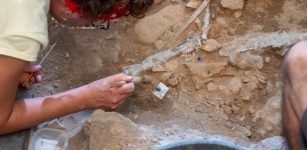 3D Models Used To Study Linya, The Prehistoric Woman Who Lived 14,000 Years Ago In Pyrenean Foothills
Archaeology | Aug 5, 2023
3D Models Used To Study Linya, The Prehistoric Woman Who Lived 14,000 Years Ago In Pyrenean Foothills
Archaeology | Aug 5, 2023 -
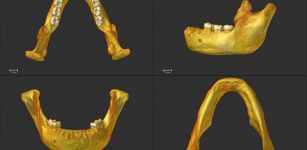 Settlement Of Europe: Result Of Several Migration Waves By A Single Population – Study
Archaeology | Jul 17, 2020
Settlement Of Europe: Result Of Several Migration Waves By A Single Population – Study
Archaeology | Jul 17, 2020 -
 Evidence Of Biblical Kingdom Of Edom In Arava Desert – Discovered
Archaeology | Sep 23, 2019
Evidence Of Biblical Kingdom Of Edom In Arava Desert – Discovered
Archaeology | Sep 23, 2019 -
 On This Day In History: Sweden’s Greatest Defeat: Battle Of Kirchholm Was Fought – On Sep 27, 1605
News | Sep 27, 2016
On This Day In History: Sweden’s Greatest Defeat: Battle Of Kirchholm Was Fought – On Sep 27, 1605
News | Sep 27, 2016 -
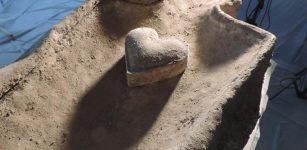 Remarkable discovery: Ancient coffins reveal centuries-old secrets of French nobility
News | Sep 1, 2015
Remarkable discovery: Ancient coffins reveal centuries-old secrets of French nobility
News | Sep 1, 2015 -
 Llanbadoc Discovery: Late Medieval Artifact And The Battle Of Usk
Artifacts | Oct 2, 2018
Llanbadoc Discovery: Late Medieval Artifact And The Battle Of Usk
Artifacts | Oct 2, 2018 -
 A 1,800-Year-Old Amasya Mosaic Goes On Display For The First Time After Seven Years
Archaeology | Jul 21, 2020
A 1,800-Year-Old Amasya Mosaic Goes On Display For The First Time After Seven Years
Archaeology | Jul 21, 2020 -
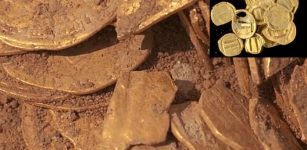 Rare Trove Of 1,100-Year-Old Gold Coins Found By Teenagers In Central Israel
Archaeology | Aug 29, 2020
Rare Trove Of 1,100-Year-Old Gold Coins Found By Teenagers In Central Israel
Archaeology | Aug 29, 2020 -
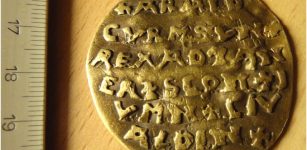 Mysterious Golden Curmsun Disc And Its Connection To King Harald Bluetooth And The Legendary Jomsvikings
Artifacts | Apr 13, 2022
Mysterious Golden Curmsun Disc And Its Connection To King Harald Bluetooth And The Legendary Jomsvikings
Artifacts | Apr 13, 2022 -
 Ancient DNA Reveals Irish Are Not Celts – Irish Ancestors Came From Biblical Lands – Scientists Say
Archaeology | Mar 30, 2020
Ancient DNA Reveals Irish Are Not Celts – Irish Ancestors Came From Biblical Lands – Scientists Say
Archaeology | Mar 30, 2020 -
 Long Serpent: Most Famous Viking Longship Of King Olav Tryggvason Of Norway And Its Fate
Featured Stories | Jun 7, 2017
Long Serpent: Most Famous Viking Longship Of King Olav Tryggvason Of Norway And Its Fate
Featured Stories | Jun 7, 2017 -
 Huge Ancient Roman Kovachevsko Kale Fortress And Discovery Of A Horreum In Bulgaria
Civilizations | Dec 15, 2015
Huge Ancient Roman Kovachevsko Kale Fortress And Discovery Of A Horreum In Bulgaria
Civilizations | Dec 15, 2015 -
 New Light On Foodways In The First Cities In Mesopotamia
Archaeology | Nov 21, 2022
New Light On Foodways In The First Cities In Mesopotamia
Archaeology | Nov 21, 2022 -
 Sinister Mythical Dark Elves And Light Elves And Their Magical Ship ‘Skidbladnir’
Featured Stories | Oct 3, 2016
Sinister Mythical Dark Elves And Light Elves And Their Magical Ship ‘Skidbladnir’
Featured Stories | Oct 3, 2016 -
 Olmec Civilization Remains An Intriguing Ancient Puzzle
Civilizations | Feb 2, 2017
Olmec Civilization Remains An Intriguing Ancient Puzzle
Civilizations | Feb 2, 2017 -
 Gold Coins Shed Light On The Mystery Of Sandby Borg And Massacre On The Swedish Island
Archaeology | Oct 16, 2017
Gold Coins Shed Light On The Mystery Of Sandby Borg And Massacre On The Swedish Island
Archaeology | Oct 16, 2017 -
 Well-Preserved Settlement Dated To 2,400 BC Unearthed At Tell Edfu, Egypt
Archaeology | Feb 8, 2018
Well-Preserved Settlement Dated To 2,400 BC Unearthed At Tell Edfu, Egypt
Archaeology | Feb 8, 2018 -
 Ancient Secrets Of The Theopetra Cave: World’s Oldest Man-Made Structure And Home To Humans 130,000 Years Ago
Civilizations | May 12, 2016
Ancient Secrets Of The Theopetra Cave: World’s Oldest Man-Made Structure And Home To Humans 130,000 Years Ago
Civilizations | May 12, 2016


